Rockchip first unveiled RK3399 hexa-core processor at the beginning of 2016, but we had to wait longer than expected to get devices to play with. The first retail product based on the processor is really Samsung Chromebook Plus, and we only saw a few TV boxes for pre-sale in January such as Yundoo Y8 or R-TV Box K99, and with the first shipments occurring in March. However, I’ve also noticed many companies postponed the launch of the RK3399 mini PC/TV box, and no company contacted me for review so far, so I had no rush because that probably means the boxes were not quite ready. But starting at the beginning of next month, more companies will start selling their model, and GearBest proposed to send me Yundoo Y8 model with 4GB RAm, 32GB flash, and decided to give it a go. In this first part of the review, I’ll only look at the hardware, and will further test overall performance, video & audio capabilities, in subsequent posts.
Yundoo Y8 Unboxing
The retail package refers to Yundoo Y8 “True 4K” media player.
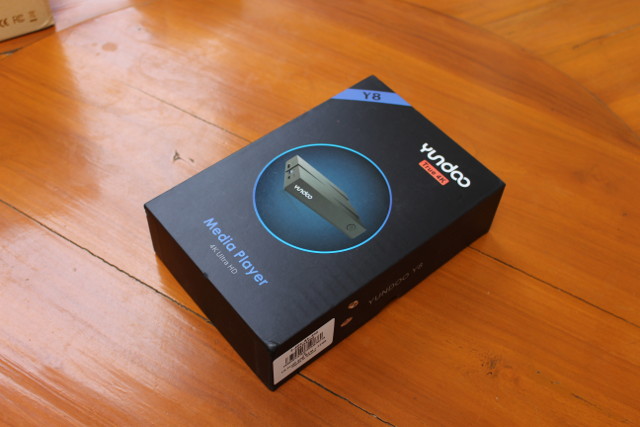
There are two version for Y8 model one with 2GB RAM, 16GB storage, and the other with 4GB RAM/32GB storage which I received,
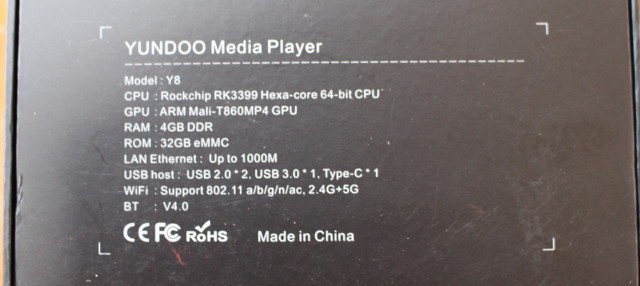
The box ships with a HDMI cable, an infrared remote control with IR learning function for 5 keys, a 5V/2.5A power supply, and a rather useless user manual.
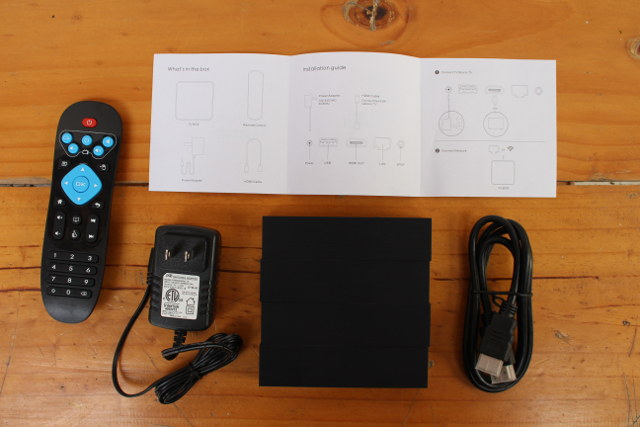
The enclosure is made of plastic with the power button on the front panel, an SD card, USB 3.0 port, and USB type C port on one of the side, with the rest of the ports on the rear panel: DC jack, optical S/PDIF, AV port (composite + stereo audio), Gigabit Ethernet, HDMI 2.0, and two USB 2.0 ports.
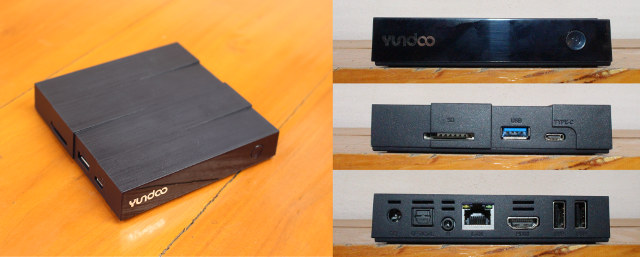
You may watch the unboxing video if you please.
Yundoo Y8 Teardown
We’ll start our unboxing by removing 3 rubber pads from the bottom of the case, and loosen the three screws underneath. You can leave the one at the top left alone, since there’s nothing there.
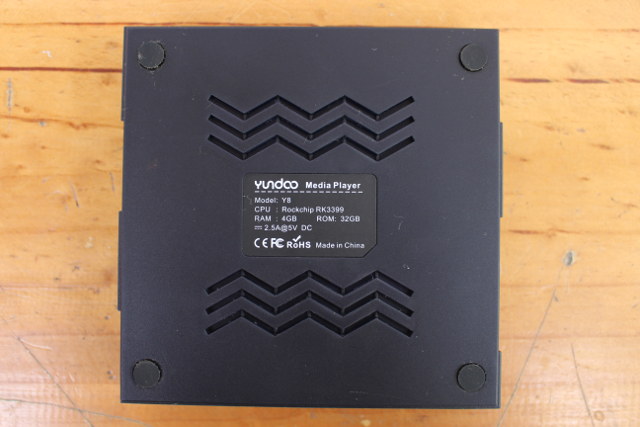
The gap between the two side of the enclosure is extremely small, and my green plastic tool was not sharp enough, so I took a bit more risks and used a sharper metal tool to get started with popping up the bottom part of the case, before carrying on with the plastic tool.
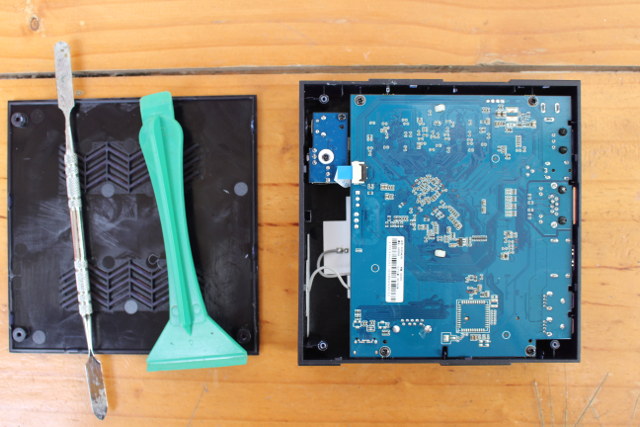
There’s no much to see on the bottom of the board, except a footprint for a wireless module with one antenna, and the sticker showing the key features of the board: RK3399, 4G/32G, and AP6356 wireless module. After removing four more screws, we can completely take the board out.
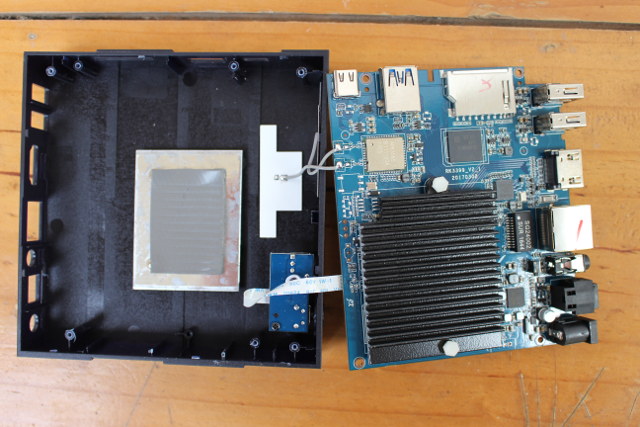
A large heatsink covers the processor and RAM chips, and it’s further cooled by a thermal pad and a thick metal plate attached to the box of the case. Two antennas are connected to the Wireless module, which could help with WiFi reliability and/or performance. The power button and LED is located in a separate small board.
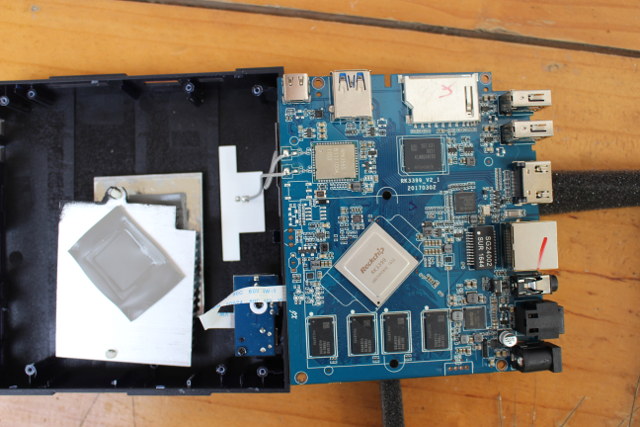
I’ve removed the heatsink to have a better look at the board, Note that there’s no thermal paste between the heatsink and the processor, but instead the company used another thermal pad.
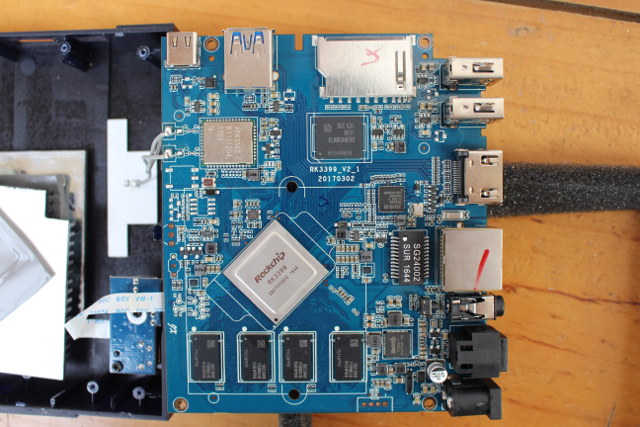
Rockchip RK3399 processor is connected to four Samsung K4B8G1646D-MYK0 DDR3L chip (4x 1GByte), and a 32GB Samsung KLMBG4WEBD-B031 eMMC 5.0 flash with theoretical 260/46 MB/s sequential read and write speed, and 6000/5000 R/W IOPS, which should offer a good user experience. That’s still the lowest end 32GB Samsung eMMC flash there is. Ampak AP6356S module brings dual band 802.11 b/g/n/ac 2×2 (Up to 867 Mbps) and Bluetooth 4.1 LE connectivity to the board, while Gigabit Ethernet is made possible thanks to ZTE ZX2AA500 transceiver – no a Realtek chip for once – and SG24002 magnetics. Rockchip RK808-D PMIC completes the list of the mains chips on the board. You may have also noticed the unpopulated 4-pin header on the bottom right of the board which should be the serial console. The firmware recovery button is hidden right behind the AV port.
I’d like to thank GearBest for sending a sample for review. If you are interested you could purchase the device on their website for $109.99 with coupon GBYDY8, or $90 with coupon GBYDY816 for the 2GB/16GB version. Yundoo Y8 appears to be a GearBest exclusivity, as I failed to find it on Aliexpress, GeekBuying and other websites.
Continue reading Yundoo Y8 Rockchip RK3399 mini PC Review – Part 2: Android Firmware, Audio & Video Playback in Kodi.

Jean-Luc started CNX Software in 2010 as a part-time endeavor, before quitting his job as a software engineering manager, and starting to write daily news, and reviews full time later in 2011.
Support CNX Software! Donate via cryptocurrencies, become a Patron on Patreon, or purchase goods on Amazon or Aliexpress




